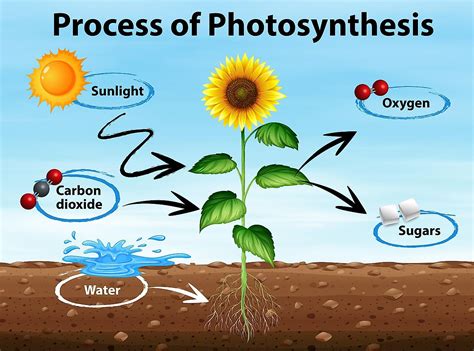Photosynthesis, the intricate process by which plants and some other organisms convert sunlight into chemical energy, is a cornerstone of life on Earth. Understanding the input and output of photosynthesis is essential to appreciate its significance and envision its potential applications.

Input
The primary inputs of photosynthesis are:
1. Sunlight: The electromagnetic energy from the sun provides the power for the photosynthetic reactions. Plants capture sunlight through pigments, primarily chlorophyll, present in their leaves.
2. Carbon Dioxide (CO2): CO2 from the atmosphere diffuses into plant leaves through tiny pores called stomata. It serves as the main carbon source for photosynthesis.
3. Water (H2O): Water is absorbed from the soil by plant roots and transported to the leaves. It provides the hydrogen ions needed for photosynthesis and helps regulate leaf temperature.
Output
Photosynthesis produces several crucial outputs:
1. Glucose: Glucose is the primary sugar molecule produced during photosynthesis. It serves as the primary energy source for plants and the base for cellulose, the main component of plant cell walls.
2. Oxygen (O2): As a byproduct of photosynthesis, oxygen is released into the atmosphere. It is essential for cellular respiration in all organisms.
3. ATP (Adenosine Triphosphate): ATP is an energy-carrier molecule produced during photosynthesis. Plants use ATP to power various cellular processes, including glucose synthesis.
Energy Transfer in Photosynthesis
The input and output of photosynthesis are interconnected through two primary stages:
-
Light-Dependent Reactions: These reactions occur in the thylakoid membranes of chloroplasts (in plant cells) or chromatophores (in bacteria). Sunlight is absorbed by chlorophyll, and the energy is used to generate ATP and NADPH (nicotinamide adenine dinucleotide phosphate), which are energy carriers.
-
Light-Independent Reactions (Calvin Cycle): These reactions occur in the stroma of chloroplasts and use the ATP and NADPH generated during the light-dependent reactions to convert CO2 and hydrogen ions into glucose.
Quantitative Aspects of Photosynthesis
According to the Environmental Protection Agency (EPA), photosynthesis consumes approximately 1% of the total solar radiation reaching Earth. This energy conversion results in the production of an estimated 100-115 gigatons of dry organic matter per year.
Efficiency Enhancements
Scientists are actively researching ways to enhance the efficiency of photosynthesis. One promising approach involves engineering plants with increased photosynthetic capacity by manipulating genes that regulate light harvesting and carbon fixation.
Applications and Innovations
The understanding of photosynthesis inputs and outputs paves the way for innovative applications:
-
Biofuel Production: The glucose produced during photosynthesis can be converted into biofuels, such as ethanol and biodiesel, as alternatives to fossil fuels.
-
Carbon Sequestration: Plants absorb CO2 during photosynthesis, contributing to carbon sequestration and mitigating climate change.
-
Food Security: By improving photosynthetic efficiency, we can increase crop yields and address global food security challenges.
Tables
| Input | Output |
|---|---|
| Sunlight | Glucose |
| Carbon Dioxide (CO2) | Oxygen (O2) |
| Water (H2O) | ATP |
| Process | Location |
|---|---|
| Light-Dependent Reactions | Thylakoid membranes |
| Light-Independent Reactions (Calvin Cycle) | Stroma |
| Organization | Photosynthesis Facts |
|---|---|
| EPA | Consumes 1% of solar radiation |
| Global Carbon Project | Produces 100-115 gigatons of organic matter annually |
| Organization | Photosynthesis Efficiency Research |
|---|---|
| Lawrence Berkeley National Laboratory | Gene manipulation for increased light harvesting |
| Carnegie Institution | Engineering carbon fixation pathways |
Effective Strategies for Photosynthesis Optimization
-
Maximize Sunlight Exposure: Provide ample sunlight to plants by planting in open areas or using artificial lighting in controlled environments.
-
Ensure CO2 Availability: Increase CO2 concentration in greenhouses or controlled environments to enhance photosynthesis.
-
Optimize Water Supply: Provide adequate water for plant growth and photosynthesis, especially during periods of drought.
Tips and Tricks for Enhancing Leaf Photosynthesis
-
Prune Regularly: Removing old or damaged leaves allows sunlight to reach young, healthy leaves.
-
Fertilize Regularly: Essential nutrients, such as nitrogen, phosphorus, and potassium, promote plant growth and photosynthesis.
-
Water Consistently: Regular watering prevents wilting and ensures adequate water supply for photosynthesis.
Frequently Asked Questions (FAQs)
-
What happens to the oxygen produced during photosynthesis?
– Oxygen is released into the atmosphere where it is used by organisms for cellular respiration. -
Why is photosynthesis important for the environment?
– Photosynthesis absorbs CO2 from the atmosphere, reducing greenhouse gas levels and contributing to climate change mitigation. -
How can we harness photosynthesis for future applications?
– By manipulating and engineering photosynthetic processes, we can develop biofuels, enhance food security, and improve environmental sustainability. -
What is the significance of ATP in photosynthesis?
– ATP is the energy carrier molecule that powers the conversion of CO2 and hydrogen ions into glucose. -
Can photosynthesis occur in the absence of sunlight?
– No, sunlight is the primary energy source for photosynthesis, and the process cannot occur without it. -
What are the challenges in enhancing photosynthesis efficiency?
– Manipulating complex photosynthetic pathways, ensuring scalability, and minimizing potential negative impacts on plant growth are among the challenges faced in photosynthesis research.
